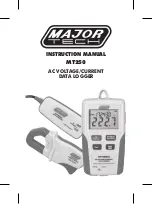
Section 7. Installation
198
Note This instruction should not normally be inserted within a For/Next
construct with the Source and Destination parameters indexed and Reps
set to 1. Doing so will perform a single running average, using the values
of the different elements of the array, instead of performing an
independent running average on each element of the array. The results
will be a running average of a spatial average of the various source array
elements.
A running average is a digital low-pass filter; its output is attenuated as a function
of frequency, and its output is delayed in time. Degree of attenuation and phase
shift (time delay) depend on the frequency of the input signal and the time length
(which is related to the number of points) of the running average.
The figure Running-Average Frequency Response
(p. 200)
is a graph of signal
attenuation plotted against signal frequency normalized to 1/(running average
duration). The signal is attenuated by a synchronizing filter with an order of 1
(simple averaging): Sin(πX) / (πX), where X is the ratio of the input signal
frequency to the running-average frequency (running-
average frequency = 1 /
time length of the running average).
Example:
Scan period = 1 ms,
N value = 4 (number of poin
ts to average),
Running-
average duration = 4 ms
Running-
average frequency = 1 / (running
-
average duration = 250 Hz)
Input-
signal frequency = 100 Hz
Input frequency to running average (normalized frequency) = 100 / 250 = 0.4
Sin(0.4π) / (0.4π) = 0.757 (or r
ead from figure Running-Average Frequency
Response
(p. 200),
where the X axis is 0.4)
For a 100 Hz input signal with an amplitude of 10 V peak-to-peak, a running
average outputs a 100 Hz signal with an amplitude of 7.57 V peak-to-peak.
There is also a phase shift, or delay, in the AvgRun() output. The formula for
calculating the delay, in number of samples, is:
Delay in samples = (N
–1) / 2
Note N = number of points in running average
To calculate the delay in time, multiply the result from the above equation by the
period at which the running average is executed (usually the scan period):
Delay in time = (scan period) • (N
–1) / 2
Содержание CR3000 Micrologger
Страница 2: ......
Страница 3: ......
Страница 4: ......
Страница 6: ......
Страница 30: ......
Страница 34: ......
Страница 36: ......
Страница 96: ......
Страница 200: ...Section 7 Installation 200 FIGURE 42 Running Average Frequency Response FIGURE 43 Running Average Signal Attenuation ...
Страница 485: ...Section 8 Operation 485 8 11 2 Data Display FIGURE 110 Keyboard and Display Displaying Data ...
Страница 487: ...Section 8 Operation 487 FIGURE 112 CR1000KD Real Time Custom ...
Страница 488: ...Section 8 Operation 488 8 11 2 3 Final Storage Data FIGURE 113 Keyboard and Display Final Storage Data ...
Страница 489: ...Section 8 Operation 489 8 11 3 Run Stop Program FIGURE 114 Keyboard and Display Run Stop Program ...
Страница 491: ...Section 8 Operation 491 FIGURE 116 Keyboard and Display File Edit ...
Страница 495: ...Section 8 Operation 495 Low power standby whenever possible Low power bus sets bus and modules to low power ...
Страница 496: ......
Страница 502: ......
Страница 564: ...Section 11 Glossary 564 FIGURE 126 Relationships of Accuracy Precision and Resolution ...
Страница 566: ......
Страница 594: ......
Страница 598: ......
Страница 600: ......
Страница 602: ......
Страница 624: ......
Страница 642: ......
Страница 643: ......
















































